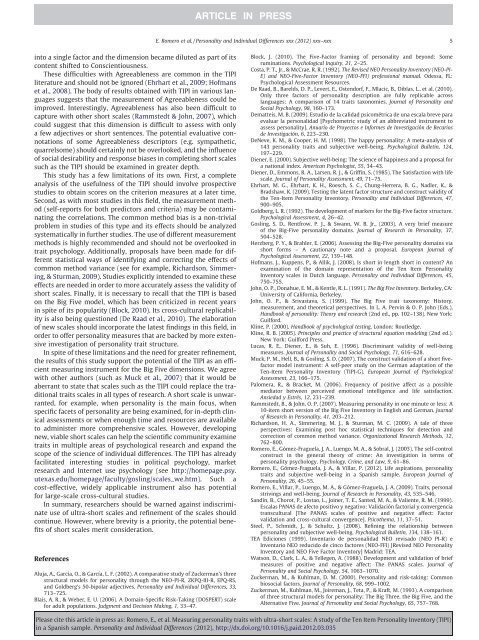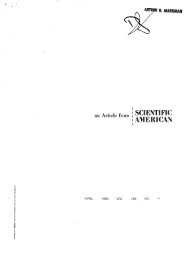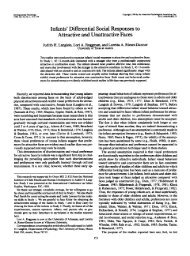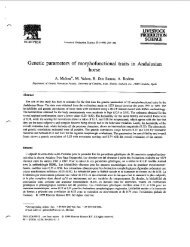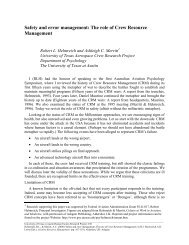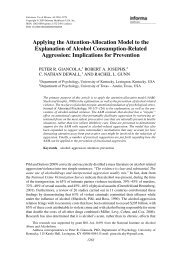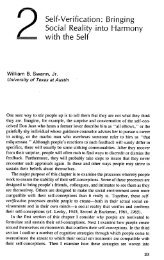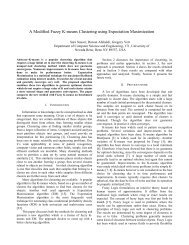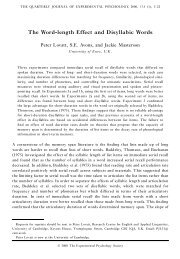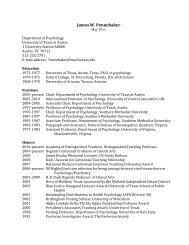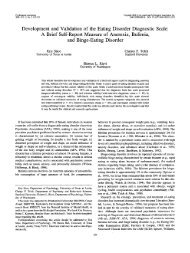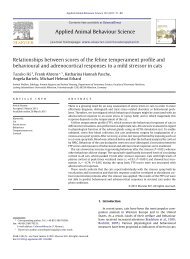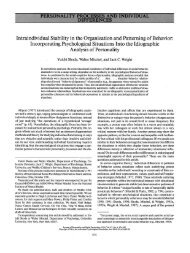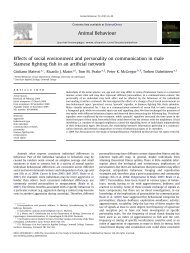Measuring personality traits with ultra-short scales: A study of the ...
Measuring personality traits with ultra-short scales: A study of the ...
Measuring personality traits with ultra-short scales: A study of the ...
You also want an ePaper? Increase the reach of your titles
YUMPU automatically turns print PDFs into web optimized ePapers that Google loves.
E. Romero et al. / Personality and Individual Differences xxx (2012) xxx–xxx 5<br />
into a single factor and <strong>the</strong> dimension became diluted as part <strong>of</strong> its<br />
content shifted to Conscientiousness.<br />
These difficulties <strong>with</strong> Agreeableness are common in <strong>the</strong> TIPI<br />
literature and should not be ignored (Ehrhart et al., 2009; H<strong>of</strong>mans<br />
et al., 2008). The body <strong>of</strong> results obtained <strong>with</strong> TIPI in various languages<br />
suggests that <strong>the</strong> measurement <strong>of</strong> Agreeableness could be<br />
improved. Interestingly, Agreeableness has also been difficult to<br />
capture <strong>with</strong> o<strong>the</strong>r <strong>short</strong> <strong>scales</strong> (Rammstedt & John, 2007), which<br />
could suggest that this dimension is difficult to assess <strong>with</strong> only<br />
a few adjectives or <strong>short</strong> sentences. The potential evaluative connotations<br />
<strong>of</strong> some Agreeableness descriptors (e.g. sympa<strong>the</strong>tic,<br />
quarrelsome) should certainly not be overlooked, and <strong>the</strong> influence<br />
<strong>of</strong> social desirability and response biases in completing <strong>short</strong> <strong>scales</strong><br />
such as <strong>the</strong> TIPI should be examined in greater depth.<br />
This <strong>study</strong> has a few limitations <strong>of</strong> its own. First, a complete<br />
analysis <strong>of</strong> <strong>the</strong> usefulness <strong>of</strong> <strong>the</strong> TIPI should involve prospective<br />
studies to obtain scores on <strong>the</strong> criterion measures at a later time.<br />
Second, as <strong>with</strong> most studies in this field, <strong>the</strong> measurement method<br />
(self-reports for both predictors and criteria) may be contaminating<br />
<strong>the</strong> correlations. The common method bias is a non-trivial<br />
problem in studies <strong>of</strong> this type and its effects should be analyzed<br />
systematically in fur<strong>the</strong>r studies. The use <strong>of</strong> different measurement<br />
methods is highly recommended and should not be overlooked in<br />
trait psychology. Additionally, proposals have been made for different<br />
statistical ways <strong>of</strong> identifying and correcting <strong>the</strong> effects <strong>of</strong><br />
common method variance (see for example, Richardson, Simmering,<br />
& Sturman, 2009). Studies explicitly intended to examine <strong>the</strong>se<br />
effects are needed in order to more accurately assess <strong>the</strong> validity <strong>of</strong><br />
<strong>short</strong> <strong>scales</strong>. Finally, it is necessary to recall that <strong>the</strong> TIPI is based<br />
on <strong>the</strong> Big Five model, which has been criticized in recent years<br />
in spite <strong>of</strong> its popularity (Block, 2010). Its cross-cultural replicability<br />
is also being questioned (De Raad et al., 2010). The elaboration<br />
<strong>of</strong> new <strong>scales</strong> should incorporate <strong>the</strong> latest findings in this field, in<br />
order to <strong>of</strong>fer <strong>personality</strong> measures that are backed by more extensive<br />
investigation <strong>of</strong> <strong>personality</strong> trait structure.<br />
In spite <strong>of</strong> <strong>the</strong>se limitations and <strong>the</strong> need for greater refinement,<br />
<strong>the</strong> results <strong>of</strong> this <strong>study</strong> support <strong>the</strong> potential <strong>of</strong> <strong>the</strong> TIPI as an efficient<br />
measuring instrument for <strong>the</strong> Big Five dimensions. We agree<br />
<strong>with</strong> o<strong>the</strong>r authors (such as Muck et al., 2007) that it would be<br />
aberrant to state that <strong>scales</strong> such as <strong>the</strong> TIPI could replace <strong>the</strong> traditional<br />
<strong>traits</strong> <strong>scales</strong> in all types <strong>of</strong> research. A <strong>short</strong> scale is unwarranted,<br />
for example, when <strong>personality</strong> is <strong>the</strong> main focus, when<br />
specific facets <strong>of</strong> <strong>personality</strong> are being examined, for in-depth clinical<br />
assessments or when enough time and resources are available<br />
to administer more comprehensive <strong>scales</strong>. However, developing<br />
new, viable <strong>short</strong> <strong>scales</strong> can help <strong>the</strong> scientific community examine<br />
<strong>traits</strong> in multiple areas <strong>of</strong> psychological research and expand <strong>the</strong><br />
scope <strong>of</strong> <strong>the</strong> science <strong>of</strong> individual differences. The TIPI has already<br />
facilitated interesting studies in political psychology, market<br />
research and Internet use psychology (see http://homepage.psy.<br />
utexas.edu/homepage/faculty/gosling/<strong>scales</strong>_we.htm). Such a<br />
cost-effective, widely applicable instrument also has potential<br />
for large-scale cross-cultural studies.<br />
In summary, researchers should be warned against indiscriminate<br />
use <strong>of</strong> <strong>ultra</strong>-<strong>short</strong> <strong>scales</strong> and refinement <strong>of</strong> <strong>the</strong> <strong>scales</strong> should<br />
continue. However, where brevity is a priority, <strong>the</strong> potential benefits<br />
<strong>of</strong> <strong>short</strong> <strong>scales</strong> merit consideration.<br />
References<br />
Aluja, A., García, O., & García, L. F. (2002). A comparative <strong>study</strong> <strong>of</strong> Zuckerman’s three<br />
structural models for <strong>personality</strong> through <strong>the</strong> NEO-PI-R, ZKPQ-III-R, EPQ-RS,<br />
and Goldberg’s 50-bipolar adjectives. Personality and Individual Differences, 33,<br />
713–725.<br />
Blais, A. R., & Weber, E. U. (2006). A Domain-Specific Risk-Taking (DOSPERT) scale<br />
for adult populations. Judgment and Decision Making, 1, 33–47.<br />
Block, J. (2010). The Five-Factor framing <strong>of</strong> <strong>personality</strong> and beyond: Some<br />
ruminations. Psychological Inquiry, 21, 2–25.<br />
Costa, P. T., Jr., & McCrae, R. R. (1992). The Revised NEO Personality Inventory (NEO-PI-<br />
E) and NEO-Five-Factor Inventory (NEO-FFI) pr<strong>of</strong>essional manual. Odessa, FL:<br />
Psychological Assessment Resources.<br />
De Raad, B., Barelds, D. P., Levert, E., Ostendorf, F., Mlacic, B., Diblas, L., et al. (2010).<br />
Only three factors <strong>of</strong> <strong>personality</strong> description are fully replicable across<br />
languages: A comparison <strong>of</strong> 14 <strong>traits</strong> taxonomies. Journal <strong>of</strong> Personality and<br />
Social Psychology, 98, 160–173.<br />
Dematteis, M. B. (2009). Estudio de la calidad psicométrica de una escala breve para<br />
evaluar la personalidad [Psychometric <strong>study</strong> <strong>of</strong> an abbreviated instrument to<br />
assess <strong>personality</strong>]. Anuario de Proyectos e Informes de Investigación de Becarios<br />
de Investigación, 6, 223–230.<br />
DeNeve, K. M., & Cooper, H. M. (1998). The happy <strong>personality</strong>: A meta-analysis <strong>of</strong><br />
143 <strong>personality</strong> <strong>traits</strong> and subjective well-being. Psychological Bulletin, 124,<br />
197–229.<br />
Diener, E. (2000). Subjective well-being: The science <strong>of</strong> happiness and a proposal for<br />
a national index. American Psychologist, 55, 34–43.<br />
Diener, D., Emmons, R. A., Larsen, R. J., & Griffin, S. (1985). The Satisfaction <strong>with</strong> life<br />
scale. Journal <strong>of</strong> Personality Assessment, 49, 71–75.<br />
Ehrhart, M. G., Ehrhart, K. H., Roesch, S. C., Chung-Herrera, B. G., Nadler, K., &<br />
Bradshaw, K. (2009). Testing <strong>the</strong> latent factor structure and construct validity <strong>of</strong><br />
<strong>the</strong> Ten-Item Personality Inventory. Personality and Individual Differences, 47,<br />
900–905.<br />
Goldberg, L. R. (1992). The development <strong>of</strong> markers for <strong>the</strong> Big-Five factor structure.<br />
Psychological Assessment, 4, 26–42.<br />
Gosling, S. D., Rentfrow, P. J., & Swann, W. B. Jr., (2003). A very brief measure<br />
<strong>of</strong> <strong>the</strong> Big-Five <strong>personality</strong> domains. Journal <strong>of</strong> Research in Personality, 37,<br />
504–528.<br />
Herzberg, P. Y., & Brahler, E. (2006). Assessing <strong>the</strong> Big-Five <strong>personality</strong> domains via<br />
<strong>short</strong> forms – A cautionary note and a proposal. European Journal <strong>of</strong><br />
Psychological Assessment, 22, 139–148.<br />
H<strong>of</strong>mans, J., Kuppens, P., & Allik, J. (2008). Is <strong>short</strong> in length <strong>short</strong> in content? An<br />
examination <strong>of</strong> <strong>the</strong> domain representation <strong>of</strong> <strong>the</strong> Ten Item Personality<br />
Inventory <strong>scales</strong> in Dutch language. Personality and Individual Differences, 45,<br />
750–755.<br />
John, O. P., Donahue, E. M., & Kentle, R. L. (1991). The Big Five Inventory. Berkeley, CA:<br />
University <strong>of</strong> California, Berkeley.<br />
John, O. P., & Srivastava, S. (1999). The Big Five trait taxonomy: History,<br />
measurement, and <strong>the</strong>oretical perspectives. In L. A. Pervin & O. P. John (Eds.),<br />
Handbook <strong>of</strong> <strong>personality</strong>: Theory and research (2nd ed., pp. 102–138). New York:<br />
Guilford.<br />
Kline, P. (2000). Handbook <strong>of</strong> psychological testing. London: Routledge.<br />
Kline, R. B. (2005). Principles and practice <strong>of</strong> structural equation modeling (2nd ed.).<br />
New York: Guilford Press.<br />
Lucas, R. E., Diener, E., & Suh, E. (1996). Discriminant validity <strong>of</strong> well-being<br />
measures. Journal <strong>of</strong> Personality and Social Psychology, 71, 616–628.<br />
Muck, P. M., Hell, B., & Gosling, S. D. (2007). The construct validation <strong>of</strong> a <strong>short</strong> fivefactor<br />
model instrument: A self-peer <strong>study</strong> on <strong>the</strong> German adaptation <strong>of</strong> <strong>the</strong><br />
Ten-Item Personality Inventory (TIPI-G). European Journal <strong>of</strong> Psychological<br />
Assessment, 23, 166–175.<br />
Palomera, R., & Bracket, M. (2006). Frequency <strong>of</strong> positive affect as a possible<br />
mediator between perceived emotional intelligence and life satisfaction.<br />
Ansiedad y Estrés, 12, 231–239.<br />
Rammstedt, B., & John, O. P. (2007). <strong>Measuring</strong> <strong>personality</strong> in one minute or less: A<br />
10-item <strong>short</strong> version <strong>of</strong> <strong>the</strong> Big Five Inventory in English and German. Journal<br />
<strong>of</strong> Research in Personality, 41, 203–212.<br />
Richardson, H. A., Simmering, M. J., & Sturman, M. C. (2009). A tale <strong>of</strong> three<br />
perspectives: Examining post hoc statistical techniques for detection and<br />
correction <strong>of</strong> common method variance. Organizational Research Methods, 12,<br />
762–800.<br />
Romero, E., Gómez-Fraguela, J. A., Luengo, M. A., & Sobral, J. (2003). The self-control<br />
construct in <strong>the</strong> general <strong>the</strong>ory <strong>of</strong> crime: An investigation in terms <strong>of</strong><br />
<strong>personality</strong> psychology. Psychology, Crime, and Law, 9, 61–86.<br />
Romero, E., Gómez-Fraguela, J. A., & Villar, P. (2012). Life aspirations, <strong>personality</strong><br />
<strong>traits</strong> and subjective well-being in a Spanish sample. European Journal <strong>of</strong><br />
Personality, 26, 45–55.<br />
Romero, E., Villar, P., Luengo, M. A., & Gómez-Fraguela, J. A. (2009). Traits, personal<br />
strivings and well-being. Journal <strong>of</strong> Research in Personality, 43, 535–546.<br />
Sandín, B., Chorot, P., Lostao, L., Joiner, T. E., Santed, M. A., & Valiente, R. M. (1999).<br />
Escalas PANAS de afecto positivo y negativo: Validación factorial y convergencia<br />
transcultural [The PANAS <strong>scales</strong> <strong>of</strong> positive and negative affect: Factor<br />
validation and cross-cultural convergence]. Psico<strong>the</strong>ma, 11, 37–51.<br />
Steel, P., Schmidt, J., & Schultz, J. (2008). Refining <strong>the</strong> relationship between<br />
<strong>personality</strong> and subjective well-being. Psychological Bulletin, 134, 138–161.<br />
TEA Ediciones (1999). Inventario de personalidad NEO revisado (NEO PI-R) e<br />
Inventario NEO reducido de cinco factores (NEO-FFI) [Revised NEO Personality<br />
Inventory and NEO Five Factor Inventory] Madrid: TEA.<br />
Watson, D., Clark, L. A., & Tellegen, A. (1988). Development and validation <strong>of</strong> brief<br />
measures <strong>of</strong> positive and negative affect: The PANAS <strong>scales</strong>. Journal <strong>of</strong><br />
Personality and Social Psychology, 54, 1063–1070.<br />
Zuckerman, M., & Kuhlman, D. M. (2000). Personality and risk-taking: Common<br />
biosocial factors. Journal <strong>of</strong> Personality, 68, 999–1002.<br />
Zuckerman, M., Kuhlman, M., Joireman, J., Teta, P., & Kraft, M. (1993). A comparison<br />
<strong>of</strong> three structural models for <strong>personality</strong>: The Big Three, <strong>the</strong> Big Five, and <strong>the</strong><br />
Alternative Five. Journal <strong>of</strong> Personality and Social Psychology, 65, 757–768.<br />
Please cite this article in press as: Romero, E., et al. <strong>Measuring</strong> <strong>personality</strong> <strong>traits</strong> <strong>with</strong> <strong>ultra</strong>-<strong>short</strong> <strong>scales</strong>: A <strong>study</strong> <strong>of</strong> <strong>the</strong> Ten Item Personality Inventory (TIPI)<br />
in a Spanish sample. Personality and Individual Differences (2012), http://dx.doi.org/10.1016/j.paid.2012.03.035


